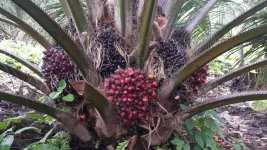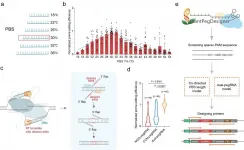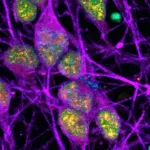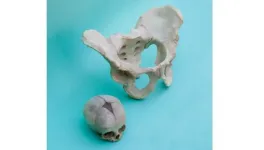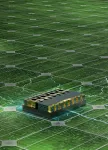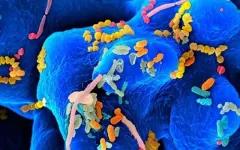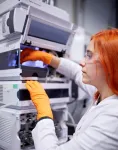(Press-News.org) DURHAM, N.C. - Engineers at Duke University have developed an electronics-free, entirely soft robot shaped like a dragonfly that can skim across water and react to environmental conditions such as pH, temperature or the presence of oil. The proof-of-principle demonstration could be the precursor to more advanced, autonomous, long-range environmental sentinels for monitoring a wide range of potential telltale signs of problems.
The soft robot is described online March 25 in the journal Advanced Intelligent Systems.
Soft robots are a growing trend in the industry due to their versatility. Soft parts can handle delicate objects such as biological tissues that metal or ceramic components would damage. Soft bodies can help robots float or squeeze into tight spaces where rigid frames would get stuck.
The expanding field was on the mind of Shyni Varghese, professor of biomedical engineering, mechanical engineering and materials science, and orthopaedic surgery at Duke, when inspiration struck.
"I got an email from Shyni from the airport saying she had an idea for a soft robot that uses a self-healing hydrogel that her group has invented in the past to react and move autonomously," said Vardhman Kumar, a PhD student in Varghese's laboratory and first author of the paper. "But that was the extent of the email, and I didn't hear from her again for days. So the idea sort of sat in limbo for a little while until I had enough free time to pursue it, and Shyni said to go for it."
In 2012, Varghese and her laboratory created a self-healing hydrogel that reacts to changes in pH in a matter of seconds. Whether it be a crack in the hydrogel or two adjoining pieces "painted" with it, a change in acidity causes the hydrogel to form new bonds, which are completely reversible when the pH returns to its original levels.
Varghese's hastily written idea was to find a way to use this hydrogel on a soft robot that could travel across water and indicate places where the pH changes. Along with a few other innovations to signal changes in its surroundings, she figured her lab could design such a robot as a sort of autonomous environmental sensor.
With the help of Ung Hyun Ko, a postdoctoral fellow also in Varghese's laboratory, Kumar began designing a soft robot based on a fly. After several iterations, the pair settled on the shape of a dragonfly engineered with a network of interior microchannels that allow it to be controlled with air pressure.
They created the body--about 2.25 inches long with a 1.4-inch wingspan--by pouring silicon into an aluminum mold and baking it. The team used soft lithography to create interior channels and connected with flexible silicon tubing.
DraBot was born.
"Getting DraBot to respond to air pressure controls over long distances using only self-actuators without any electronics was difficult," said Ko. "That was definitely the most challenging part."
DraBot works by controlling the air pressure coming into its wings. Microchannels carry the air into the front wings, where it escapes through a series of holes pointed directly into the back wings. If both back wings are down, the airflow is blocked, and DraBot goes nowhere. But if both wings are up, DraBot goes forward.
To add an element of control, the team also designed balloon actuators under each of the back wings close to DraBot's body. When inflated, the balloons cause the wings to curl upward. By changing which wings are up or down, the researchers tell DraBot where to go.
"We were happy when we were able to control DraBot, but it's based on living things," said Kumar. "And living things don't just move around on their own, they react to their environment."
That's where self-healing hydrogel comes in. By painting one set of wings with the hydrogel, the researchers were able to make DraBot responsive to changes in the surrounding water's pH. If the water becomes acidic, one side's front wing fuses with the back wing. Instead of traveling in a straight line as instructed, the imbalance causes the robot to spin in a circle. Once the pH returns to a normal level, the hydrogel "un-heals," the fused wings separate, and DraBot once again becomes fully responsive to commands.
To beef up its environmental awareness, the researchers also leveraged the sponges under the wings and doped the wings with temperature-responsive materials. When DraBot skims over water with oil floating on the surface, the sponges will soak it up and change color to the corresponding color of oil. And when the water becomes overly warm, DraBot's wings change from red to yellow.
The researchers believe these types of measurements could play an important part in an environmental robotic sensor in the future. Responsiveness to pH can detect freshwater acidification, which is a serious environmental problem affecting several geologically-sensitive regions. The ability to soak up oils makes such long-distance skimming robots an ideal candidate for early detection of oil spills. Changing colors due to temperatures could help spot signs of red tide and the bleaching of coral reefs, which leads to decline in the population of aquatic life.
The team also sees many ways that they could improve on their proof-of-concept. Wireless cameras or solid-state sensors could enhance the capabilities of DraBot. And creating a form of onboard propellant would help similar bots break free of their tubing.
"Instead of using air pressure to control the wings, I could envision using some sort of synthetic biology that generates energy," said Varghese. "That's a totally different field than I work in, so we'll have to have a conversation with some potential collaborators to see what's possible. But that's part of the fun of working on an interdisciplinary project like this."
INFORMATION:
This work was mostly performed at Shared Materials and Instrumentation facility (SMIF) at Duke University, a core facility supported by the National Science Foundation (ECCS-1542015) as part of the National Nanotechnology Coordinated Infrastructure (NNCI).
"Microengineered Materials with Self-healing Features for Soft Robotics." V. Kumar, U. Ko, Y. Zhou, J. Hoque, G. Arya, and S. Varghese. Adv. Intel. Sys., 2021. DOI: 10.1002/aisy.202100005
Lincoln, Neb., March 25, 2021 -- Palm oil, the most important source of vegetable oil in the world, is derived from the fruit of perennial palm trees, which are farmed year-round in mostly tropical areas. The palm fruit is harvested manually every 10 days to two weeks, then transported to a mill for processing, and ultimately exported and made into a dizzying array of products from food to toiletries to biodiesel.
"You probably ate palm oil for breakfast," said Patricio Grassini, an associate professor of agronomy at the University of Nebraska-Lincoln. "There is probably palm oil in your ...
Precision genome editing enables the precise modification of DNA in living cells, thus enabling a breadth of opportunities for plant breeding. Prime editors, developed by Prof. David R. Liu and his colleagues, permit the installation of desired edits in a programmable target site. They are comprised of an engineered Cas9 nickase (H840A)-reverse transcriptase (RT) fusion protein and a prime editing guide RNA (pegRNA).
Prime editors were previously developed and optimized as an extremely versatile editing strategy for generating programmable point mutations, insertions and deletions in rice and wheat by Prof. GAO Caixia of the Institute of Genetics and Developmental Biology (IGDB) of the Chinese Academy of Sciences ...
Researchers at the National Institutes of Health (NIH) have discovered specific regions within the DNA of neurons that accumulate a certain type of damage (called single-strand breaks or SSBs). This accumulation of SSBs appears to be unique to neurons, and it challenges what is generally understood about the cause of DNA damage and its potential implications in neurodegenerative diseases.
Because neurons require considerable amounts of oxygen to function properly, they are exposed to high levels of free radicals--toxic compounds that can damage DNA within cells. ...
Fossil remains of the human pelvis are rare because the pelvic bones do not preserve very well. Therefore, it has remained unclear when human sex differences in the pelvis evolved: jointly with upright walking, or later, together with the large human brains. "We have discovered that the pattern of sex differences in the human pelvis is probably much older than previously thought", says evolutionary biologist Barbara Fischer.
A team of biologists from the University of Vienna, the KLI for Evolution and Cognition Research, and the University of Calgary compared pelvic sex differences in humans with those in chimpanzees, the most closely-related living species to modern ...
Power converters are the little-known systems that make electricity so magical. They are what allow us to plug in our computers, lamps and televisions and turn them on in a snap. Converters transform the alternating current (AC) that comes out of wall sockets into the exact level of direct current (DC) that our electronics need. But they also tend to lose, in average, up to 20% of their energy in the process.
Power converters work by using power transistors - tiny semiconductor components designed to switch on and off and withstand high voltages. Designing novel power transistors to improve the converters' efficiency is the aim of the team of EPFL engineers. With their entirely new transistor design, based on the counterintuitive application ...
University of Texas at Dallas researchers have discovered that a novel surface they developed to harvest water from the air encourages tiny water droplets to move spontaneously into larger droplets.
When researchers placed microdroplets of water on their liquid-lubricant surface, the microdroplets propelled themselves to climb, without external force, into larger droplets along an oily, ramp-shaped meniscus that forms from the lubricant around the larger droplets. The "coarsening droplet phenomenon" formed droplets large enough for harvesting.
"This meniscus-mediated climbing effect enabled rapid coalescence on hydrophilic ...
The evolving science of wisdom rests on the idea that wisdom's defined traits correspond to distinct regions of the brain, and that greater wisdom translates into greater happiness and life satisfaction while being less wise results in opposite, negative consequences.
Scientists have found in multiple studies that persons deemed to be wiser are less prone to feel lonely while those who are lonelier also tend to be less wise. In a new study, published in the March 25, 2021 issue of the journal Frontiers in Psychiatry, researchers at University of California San Diego School of Medicine take the connection between wisdom, loneliness ...
An analysis of adult human brain tissue reveals over 900 proteins tied to epilepsy. The brain disorder, estimated to afflict more than 3 million Americans, is mostly known for symptoms of hallucinations, dreamlike states, and uncontrolled, often disabling bodily seizures.
Led by researchers at NYU Grossman School of Medicine, the study examined molecular differences among the brains of 14 epilepsy patients and another group of 14 adults of similar age and gender who did not have the disease.
Study results showed that altered levels of brain proteins predominated in the hippocampus, a structure located deep inside ...
Researchers from Charité - Universitätsmedizin Berlin and the Francis Crick Institute have developed a mass spectrometry-based technique capable of measuring samples containing thousands of proteins within just a few minutes. It is faster and cheaper than a conventional blood count. To demonstrate the technique's potential, the researchers used blood plasma collected from COVID-19 patients. Using the new technology, they identified eleven previously unknown proteins which are markers of disease severity. The work has been published in Nature Biotechnology*.
Thousands of proteins are active inside the human body at any given time, providing its structure and enabling reactions which are essential to life. The body raises and lowers the activity ...
Expectant women are more likely to give birth early if they have high blood levels of a chemical used in flame retardants compared with those who have limited exposure, a new study finds.
These polybrominated diphenyl ethers (PBDEs) are used in the manufacture of furniture, carpeting, and other products to reduce flammability. Previous studies have found that the substances can leach into household dust and build up in the body where they may interfere with the thyroid, an organ that secretes brain-developing hormones. Childhood exposure to PBDEs has been linked to learning disabilities, autistic ...
